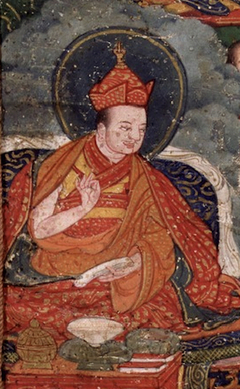Ten Virtues and Eighteen Elements
A Brief Explanation of the Ten Virtues and Eighteen Elements
by Lochen Dharmaśrī
According to the Chronicle of Ba, when the abbot [Śāntarakṣita] taught Dharma to the king for four months at Lutsuk palace and the Kashmiri Ānanda was translating, he explained the ten virtues, eighteen elements and twelve links of dependent origination. Of these, the ten virtues are easy to understand.
As for the eighteen elements, in general Dharma terminology what we call an element (khams) is dhātu, literally meaning that which holds. Here, it has the sense of something that bears its own particular characteristics. Thus, a dhātu is a sphere (dbyings) or element (khams). In this context, there are eighteen: the six faculties — the visual, auditory, olfactory, gustatory, tactile and mental faculties — which are known as the six internal elements; as well as the six external elements, which are visible forms, sounds, smells, tastes, textures and mental phenomena; and the six conscious elements, which are the visual, auditory, olfactory, gustatory, tactile and mental consciousnesses.
In this regard, the renunciation section of the Karmaśataṃ,[1] when advising on pure view, mentions the scholarly categories of the aggregates, elements, sensory sources, twelve links of dependent origination and the correct and the incorrect. As it states, the explanation of the eighteen elements serves as a supplementary guide to the five aggregates and the sensory sources. In addition, an explanation of adopting and avoiding in relation to the ten virtues provides an explanation of the correct and incorrect, and is therefore, I believe, an explanation of view and conduct at the initial stage of entering the vehicles of liberation.
Moreover, to my own inferior way of thinking, the initial establishment of the ten virtues as rules of conduct in Tibet was in accord with the following statement from the Udānavarga:
Any great one, whoever they might be,
Who holds the correct worldly view
Will not travel to the lower realms
In the course of all their future lives.[2]
As this indicates, this activity might have been intended to bring about what is called the correct view, both worldly and transcendent, and to establish confidence in karma, cause and effect. In addition, the conduct of the ten virtues brings the result of rebirth in the eighteen elements of the higher realms. As it is said:
Practising the ten virtues and avoiding non-virtue,
Is a cause of rebirth as a desire realm god or human being.
Cultivating the four immeasurables and unwavering meditation
Is a cause of rebirth in the stations of brahma and the like.
That is to say, when practice of the concentrations and formless absorptions is added to a basis of abiding by the ten vitues, virtue leads to the ten domains of the higher realms — that is, the four domains of human beings (one for each of the continents) in the desire realm and the six classes of gods in the desire realm. Then, there are four dhyāna levels in the form realm and the four spheres of perception in the formless realm. Thus, there are eighteen destinations in total.
I therefore think that the explanation of the cause, which is the ten virtues, and the result, which is the eighteen domains of gods and human beings in the higher levels of the three realms, equates to an explanation of the vehicle of gods and human beings, which is a support for the vehicles of liberation.
Furthermore, I would suggest that the explanation of the twelve links of dependent origination, which can be understood as the interdependent processes of saṃsāra and nirvāṇa — according to the forward and reverse sequence of their unfolding — covers all that is to be adopted or abandoned when entering the vehicles of liberation.
| Translated by Adam Pearcey, 2019.
Bibliography
Tibetan Edition
Dharma shrī. "dge ba bcu dang khams bco brgyad kyi bshad pa" in Dharmaśrī'i gsung 'bum. BDRC W9140. 20 vols. Dehra Dun: G.G. Khochen Tulku, 1999. Vol. 7: 503–506.
Secondary Sources
Sparham, Gareth. The Tibetan Dhammapada: Sayings of the Buddha. London: Wisdom Publications, 1986.
Wangdu, Pasang, and Hildegard Diemberger. dBa bzhed: The Royal Narrative Concerning the Bringing of the Buddha’s Doctrine to Tibet. Vienna: Verlag der Österreichische Akademie der Wissenschaften, 2000.
Version: 1.3-20230726
